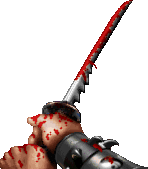
The manga-inspired artwork in the original Japanese version was also changed for release in North America, where most players were initially unaware of the game's Japanese origins. The title Western Gun, while making perfect sense for Japanese audiences in that it conveys the setting and theme as simply as possible, was considered to have sounded odd to American audiences, so it was renamed Gun Fight instead for its American localization.
GUN FIGHT GAME SPRITES LICENSE
Taito licensed its game Western Gun to Midway for release in North America, the second such license after the 1974 scrolling racing game Speed Race, also designed by Tomohiro Nishikado. In addition, in contrast to previous arcade video games such as Pong that produced blip sounds, Gun Fight featured the use of a one-channel amplifier to provide mono gunshot sounds. In contrast to earlier games which used miniature shapes to represent abstract blocks or spaceships, Western Gun featured cartoon-like human characters, influenced by Japanese manga.
While it lacked the cutscenes or fleshed-out character designs of later games due to technological limitations, the game presented early cinematic elements, through artwork of cowboys in the Wild West on the video game arcade cabinet which matched the in-game graphics featuring cacti, covered wagons, rocks, and human characters. Taito employee Tomohiro Nishikado designed Western Gun as a character-based game with fragments of a story. Gun Fight combined Western Gun with SEGA's 1969 electro-mechanical arcade game Gun Fight. On the other hand, Gun Fight had more detailed larger sprite graphics and smoother animation. Gun Fight also reduced the scale of the environment, with mountains no longer being present. In Gun Fight, each player's movement was limited to their own side of the screen, whereas the original Japanese Western Gun had free-roaming movement across anywhere on the screen. In the original Western Gun, the two cowboy gunslingers had free-roaming movement across a single-screen open-world environment, littered with cacti and mountains, while attempting to shoot each other. The gameplay was altered from Taito's original Western Gun. Gunshots can also ricochet off the top or bottom edges of the playfield, allowing for indirect hits to be used as a possible strategy. The guns have limited ammunition, with each player given six bullets a round ends if both players run out of ammo. Other features of the game included obstacles between the characters, such as a cactus, and in later levels, pine trees and moving wagons these objects serve to provide cover for the players and can be destructible. The player characters used in the game represented avatars for the players, and would yell "Got me!" when one of them is shot. It was also the first known video game to feature game characters and fragments of story through its visual presentation, marking the beginning of cinematic elements in video games. Unlike later games, Western Gun has the main joystick on the right instead of the left. The game also introduced dual-stick controls, using two distinct joystick controls per player, with one eight-way joystick for moving the computerized cowboy around on the screen and the other for changing the shooting direction. It also introduced video game violence, being the first video game to depict human-to-human combat, and the first to depict a gun on screen. Western Gun was an early, on-foot, multi-directional shooter, that could be played in single-player or two-player. The game was included in GameSpy's "Hall of Fame" in 2002. Unlike in a real-life duel, however, both cowboys get numerous opportunities to duel in order to score points (one point per successful draw). Whoever shoots the other cowboy first wins the duel. The theme of the game involves two Old West cowboys armed with revolvers and squaring off in a duel. It was soon ported to the Bally Astrocade video game console as a built-in game in 1977 as well as several home computer platforms, and has been referred to as "the Halo of its day."

It was also the first video game to use a microprocessor. Its success also opened the way for Japanese video games in the North American market. Following a flood of Pong clones, Gun Fight helped revitalize a declining arcade video game industry that was flooded with Pong clones.
Gun Fight was a major video game hit for its time, selling more than 8,000 cabinets in the US. It was a historically significant game, and a success in the arcades. Gun Fight, known as Western Gun in Japan and Europe, is a 1975 arcade shooter game designed by Tomohiro Nishikado, and released by Taito in Japan and Europe and by Midway Games in North America.


 0 kommentar(er)
0 kommentar(er)
